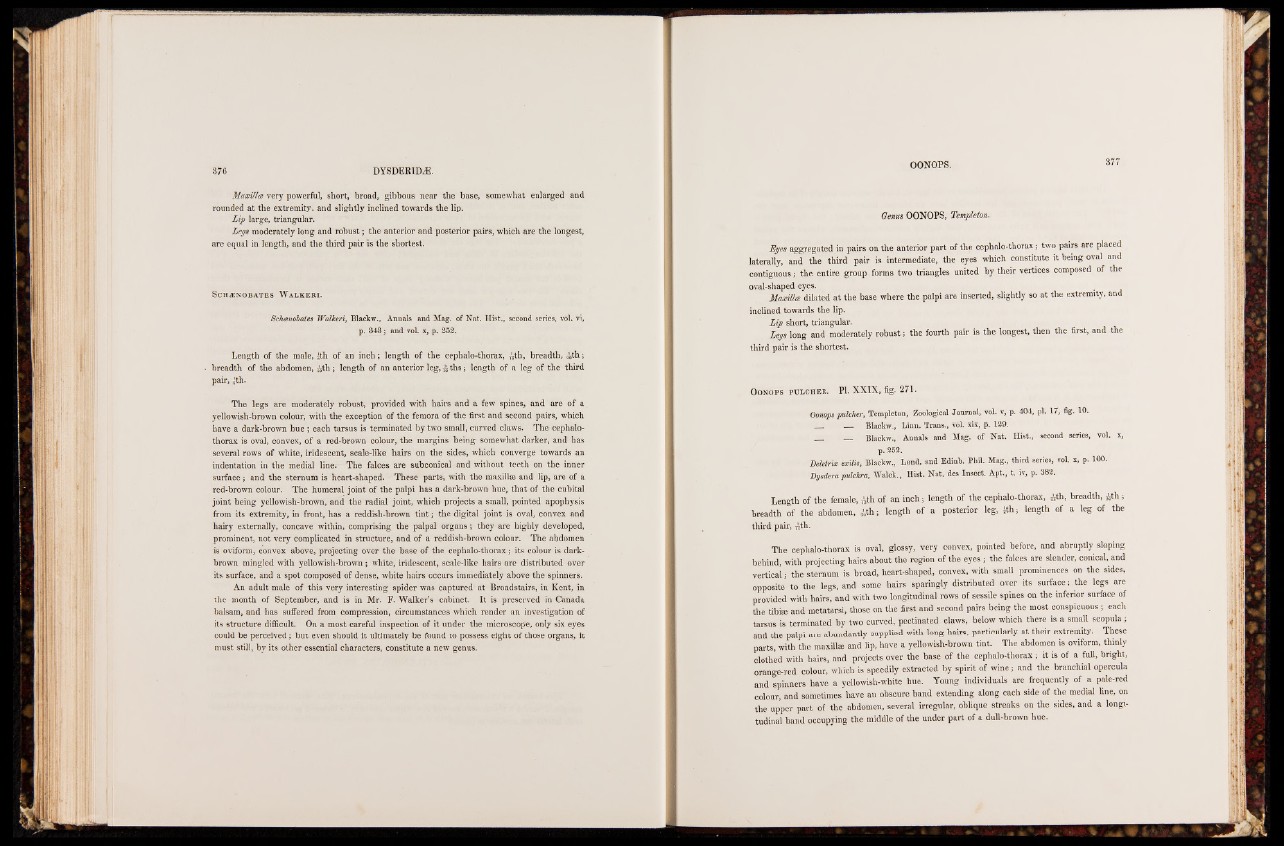
Maxilla very powerful, short, broad, gibbous near the base, somewhat enlarged and
rounded at the extremity, and slightly inclined towards the lip.
Lip large, triangular.
Legs moderately long and robust; the anterior and posterior pairs, which are the longest,
are equal in length, and the third pair is the shortest.
SCHÆNOBATES W aLKERI.
Scheenobales Walkeri, Blackw., Annals and Mag. of Nat. Hist., second series, vol. vi,
p. 343 ; and vol. x, p. 252.
Length of the male, jth of an inch; length of the cephalo-thorax, T'5th, breadth, 55th ;
breadth of the abdomen, ^th ; length of an anterior leg, ^ ths ; length of a leg of the third
pair, gth.
The legs are moderately robust, provided with hairs and a few spines, and are of a
yellowish-brown colour, with the exception of the femora of the first and second pairs, which
have a dark-brown hue ; each tarsus is terminated by two small, curved claws. The cephalo-
thorax is oval, convex, o f a red-brown colour, the margins being somewhat darker, and has
several rows of white, iridescent, scale-like hairs on the sides, which converge towards an
indentation in the medial line. The falces are subconical and without teeth on the inner
surface ; and the sternum is heart-shaped. These parts, with the raaxillæ and lip, are of a
red-brown colour. The humeral joint of the palpi has a dark-brown hue, that of the cubital
joint being yellowish-brown, and the radial joint, which projects a small, pointed apophysis
from its extremity, in front, has a reddish-brown tint ; the digital joint is oval, convex and
hairy externally, concave within, comprising the palpal organs ; they are highly developed,
prominent, not very complicated in structure, and of a reddish-brown colour. The abdomen
is oviform, convex above, projecting over the base of the cephalo-thorax ; its colour is dark-
brown mingled with yellowish-brown ; white, iridescent, scale-like hairs are distributed over
its surface, and a spot composed of dense, white hairs occurs immediately above the spinners.
An adult male of this very interesting spider was captured at Broadstairs, in Kent, in
the month of September, and is in Mr. F. Walker’s cabinet. It is preserved in Canada
balsam, and has suffered from Compression, circumstances which render an investigation of
its structure difficult. On a most careful inspection of it under the microscope, only six eyes
could be perceived ; but even should it ultimately be found to possess eight of those organs, it
must still, by its other essential characters, constitute a new genus.
Genus OONOPS, Templeton.
Eyes aggregated in pairs on the anterior part of the cephalo-thorax ; two pairs are placed
laterally, and the third pair is intermediate, the eyes which constitute it being oval and
contiguous ; the entire group forms two triangles united by their vertices composed of the
oval-shaped eyes.
Maxilla dilated at the base where the palpi are inserted, slightly so at the extremity, and
inclined towards the lip.
L ip short, triangular.
Legs long and moderately robust ; the fourth pair is the longest, then the first, and the
third pair is the shortest.
Oo nops pu l c h e r . PI. XXIX, fig. 271.
Oonops pulcher, Templeton, Zoological Journal, vol. v, p. 404, pi. 17, fig. 10.
__ — Blackw., Linn. Trans., vol. xix, p. 129.
__ __ Blackw., Annals and Mag. of Nat. Hist., second series, vol. x,
p. 252.
Deletriw exilis, Blackw., Loud, and Edinb. Phil. Mag., third series, vol. x, p. 100.
Dysdera pulchra, Walck., Hist. Nat. des Insect. Apt., t. iv, p. 382.
Length of the female, # h of an inch; length of the cephalo-thorax, £th, breadth, £th ;
breadth of the abdomen, Athj length of a posterior leg, Jth; length of a leg of the
third pair, ^th.
The cephalo-thorax is oval, glossy, very convex, pointed before, and abruptly sloping
behind, with projecting hairs about the region of the eyes ; the falces are slender, conical, and
vertical; the sternum is broad, heart-shaped, convex, with small prominences on the sides,
opposite” to the legs, and some hairs sparingly distributed over its surface; the legs are
provided with hairs, and with two longitudinal rows of sessile spines on the inferior surface of
the tibiae and metatarsi, those on the first and second pairs being the most conspicuous; each
tarsus is terminated by two curved, pectinated claws, below which there is a small scopula;
and the palpi are abundantly supplied with long hairs, particularly at their extremity. These
parts, with the maxilhe and lip, have a yellowish-brown tint. The abdomen is oviform, thinly
clothed with hairs, and projects over the base of the cephalo-thorax ; it is of a full, bright,
orange-red colour, which is speedily extracted by spirit of wine; and the branchial opercula
and spinners have a yellowish-white hue. Young individuals are frequently of a pale-red
colour, and sometimes have an obscure band extending along each side of the medial line, on
the upper part of the abdomen, several irregular, oblique streaks on the sides, and a longitudinal
band occupying the middle of the under part of a dull-brown hue.